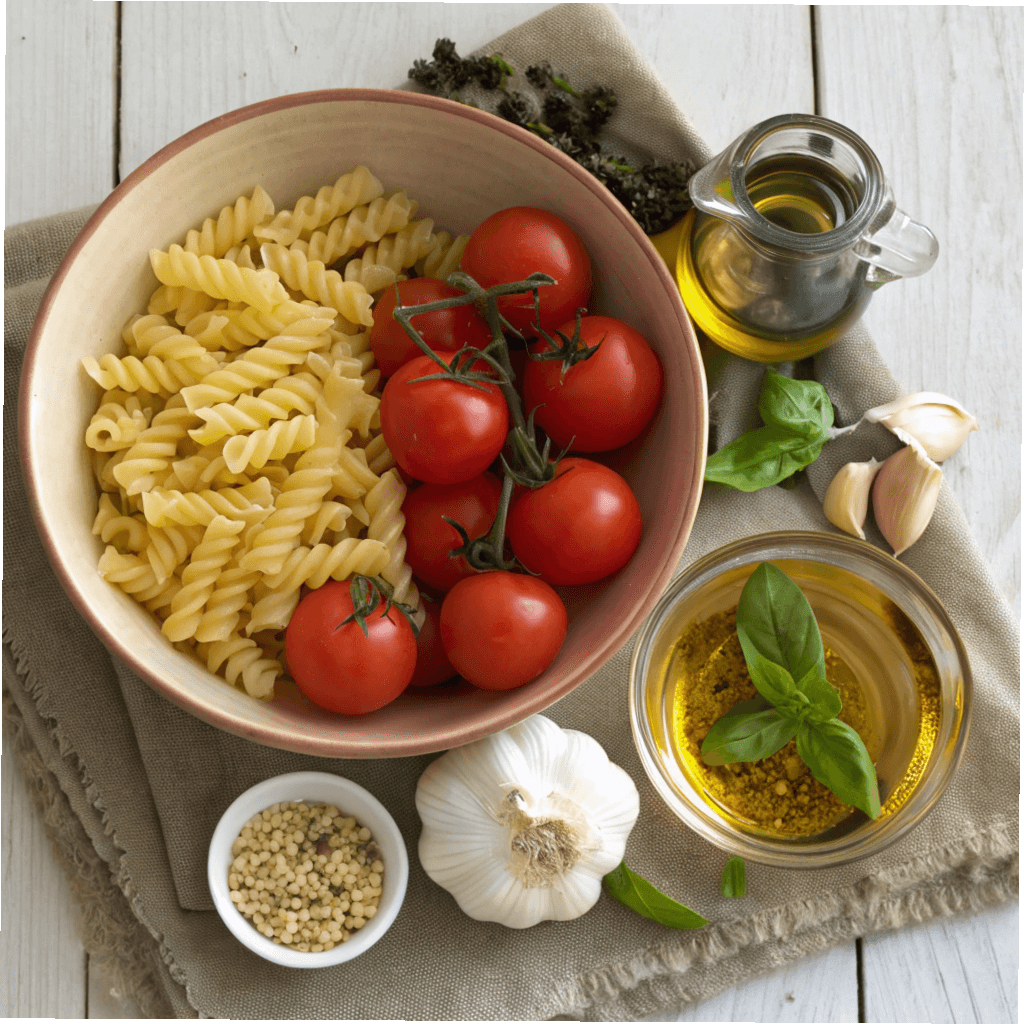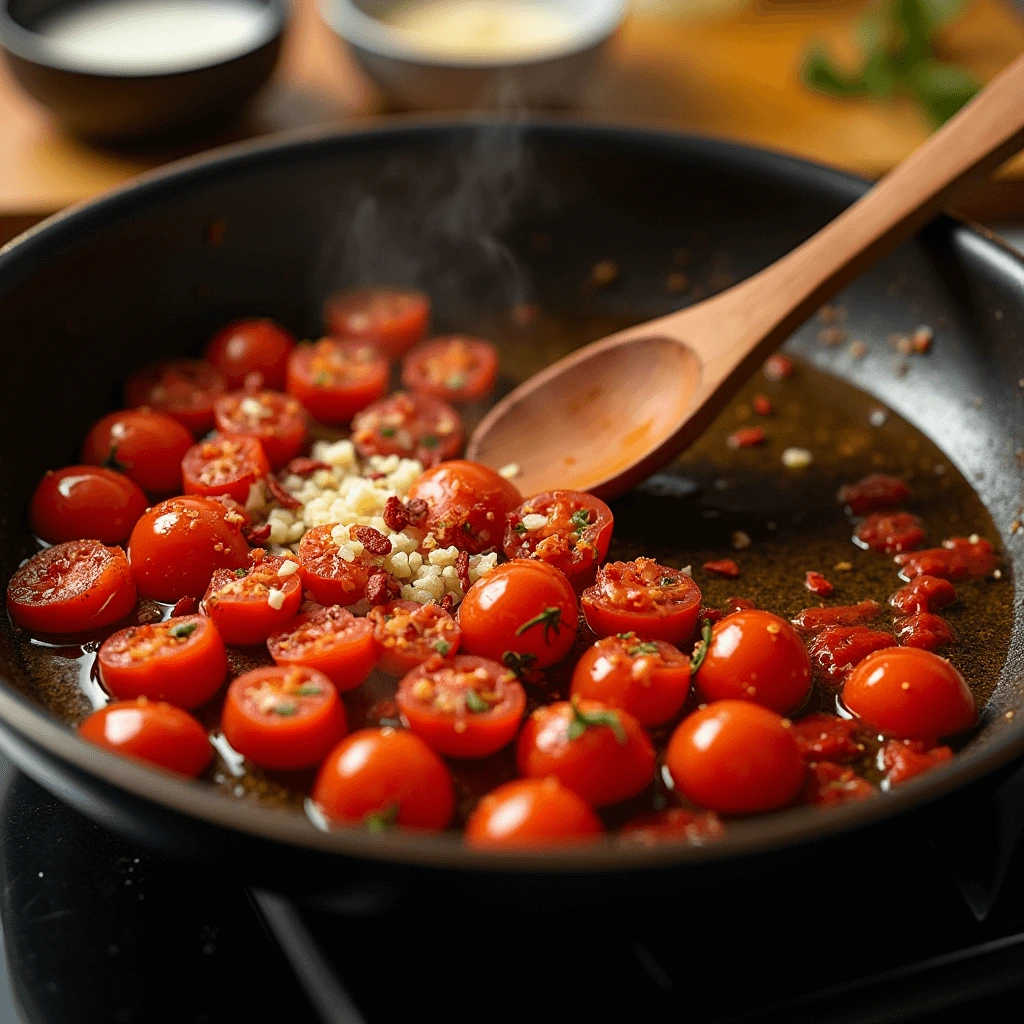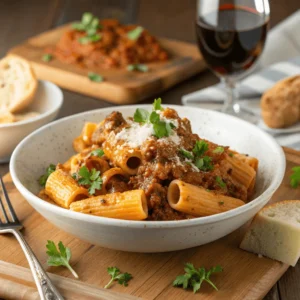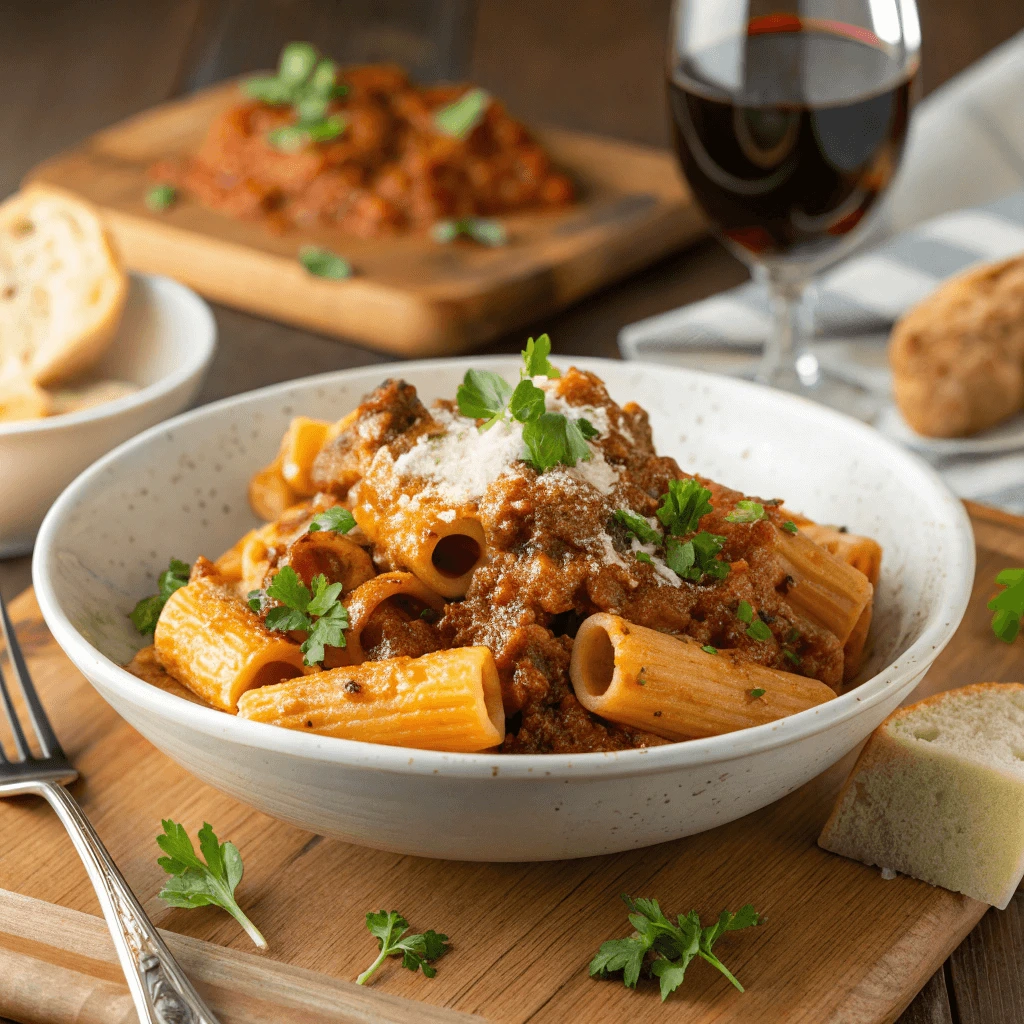Have you ever tried a pasta shape so unique it instantly becomes the star of your dinner table? Meet mafaldine pasta—a ribbon-like, curly-edged delight that’s as fun to cook as it is to eat. Whether you’re a seasoned home chef or just starting your culinary journey, this Italian-inspired dish is perfect for creating elegant yet easy meals that will impress your family and friends.
What makes mafaldine pasta so special? Its versatile texture clings beautifully to sauces, from rich and creamy to light and zesty, making every bite a flavor explosion. Plus, it’s a fantastic canvas for fresh ingredients like ripe tomatoes, fragrant basil, and savory Parmesan cheese.
In this recipe, we’ll show you how to turn simple pantry staples into a gourmet masterpiece that’s sure to steal the spotlight. Ready to elevate your pasta game? Let’s get cooking!
Table of Contents
Key Benefits of Mafaldine Pasta
Mafaldine pasta isn’t just another pasta shape—it’s a culinary experience waiting to happen. Here’s why this ribbon-like pasta deserves a spot in your kitchen:
- Versatility at Its Best: Mafaldine’s curly edges and flat surface make it perfect for holding onto sauces, whether you’re craving a creamy Alfredo, a tangy marinara, or a light olive oil and garlic drizzle. It’s a go-to choice for both hearty and delicate dishes.
- Elegant Yet Approachable: Want to impress your guests without spending hours in the kitchen? Mafaldine pasta looks gourmet but is as easy to cook as spaghetti. It’s ideal for special occasions or even a cozy weeknight dinner.
- Family-Friendly Favorite: Kids and adults alike love it’s fun shape and satisfying texture. Plus, it pairs beautifully with fresh ingredients like cherry tomatoes, spinach, or grilled chicken, making it a hit for family meals.
- Healthy and Adaptable: Looking for a gluten-free option? Many brands offer mafaldine made from alternative flours like chickpea or rice. It’s a great way to enjoy Italian-inspired meals while catering to dietary needs.
Whether you’re a pasta enthusiast or just exploring new recipes, mafaldine pasta brings rich flavor and endless possibilities to your table. Ready to see how easy it is to turn this unique pasta into a show-stopping dish? Let’s dive into the ingredients!
Ingredients for Mafaldine Pasta

Before we dive into the cooking process, let’s gather everything you’ll need to create this show-stopping mafaldine pasta dish. These fresh, high-quality ingredients come together to deliver a meal that’s bursting with flavor and texture. Here’s your checklist:
For the Pasta
- 12 oz (340g) mafaldine pasta: The star of the dish! Look for it in the pasta aisle or specialty stores.
- 1 tbsp salt: For seasoning the pasta water—it’s the secret to perfectly flavored noodles.
- 4 quarts water: Plenty of water ensures the pasta cooks evenly.
For the Sauce
- 3 tbsp extra virgin olive oil: Adds a rich, fruity base to the sauce.
- 4 garlic cloves, minced: For that irresistible aromatic kick.
- 1 cup cherry tomatoes, halved: Brings a sweet, juicy pop of flavor.
- 1 tsp red pepper flakes (optional): Perfect for a subtle spicy twist.
- 1/2 cup fresh basil leaves, chopped: Adds a fresh, herbaceous finish.
- 1/2 cup grated Parmesan cheese: For a creamy, savory touch.
- Salt and black pepper to taste: Essential for balancing the flavors.
Optional Add-Ins
- Grilled chicken or shrimp: For a protein-packed upgrade.
- Baby spinach or arugula: Adds a vibrant, leafy green element.
- Sun-dried tomatoes: Intensifies the tomato flavor with a tangy twist.
Pro Tip:
If you’re short on time, you can swap fresh cherry tomatoes for canned diced tomatoes or use pre-minced garlic. Cooking should be fun and flexible, so feel free to adapt based on what’s in your pantry!
With these ingredients ready, you’re all set to create a restaurant-worthy Mafaldine pasta dish right at home. Let’s move on to the step-by-step guide and bring this recipe to life!
How to Make Mafaldine Pasta
Ready to turn those ingredients into a mouthwatering mafaldine pasta dish? Follow these simple steps, and you’ll have a meal that’s as satisfying to make as it is to eat. Let’s get started!
Step 1: Cook the Pasta
- Bring 4 quarts of water to a rolling boil in a large pot. Add 1 tbsp of salt—this is your chance to season the pasta from the inside out.
- Add the mafaldine pasta and stir gently to prevent sticking. Cook according to the package instructions until it’s al dente (usually 9-11 minutes). You want it tender but still with a slight bite.
- Reserve 1/2 cup of pasta water before draining. This starchy liquid is gold for creating a silky, well-emulsified sauce.
Step 2: Prepare the Sauce
- While the pasta cooks, heat 3 tbsp of olive oil in a large skillet over medium heat.
- Add the minced garlic and sauté for about 1 minute until fragrant—be careful not to let it brown, as it can turn bitter.
- Toss in the halved cherry tomatoes and red pepper flakes (if using). Cook for 3-4 minutes until the tomatoes soften and release their juices, creating a light, flavorful sauce.

Step 3: Combine and Toss
- Add the cooked mafaldine pasta to the skillet with the tomato-garlic mixture. Gently toss to coat the pasta evenly.
- If the sauce feels too thick, add a splash of the reserved pasta water, a little at a time, until you reach your desired consistency.
- Stir in the chopped basil and grated Parmesan cheese, tossing everything together until the cheese melts into the sauce.
Step 4: Season and Serve
- Taste and adjust the seasoning with salt and black pepper as needed.
- For an extra touch of richness, drizzle with a bit more olive oil before serving.
Pro Tip:
If you’re adding protein like grilled chicken or shrimp, toss it in during Step 3 to warm it through. For greens like spinach or arugula, stir them in at the very end—they’ll wilt slightly from the heat, adding a fresh, vibrant element to your dish.
And there you have it—a restaurant-quality mafaldine pasta that’s ready to steal the spotlight at your table. Up next, let’s explore some pro tips and variations to make this recipe your own!
Pro Tips and Variations
Now that you’ve mastered the basics of making mafaldine pasta, let’s take it up a notch with some pro tips and creative variations. Whether you’re looking to save time, cater to dietary preferences, or simply experiment with new flavors, these ideas will help you make this recipe truly your own.
Pro Tips for Perfect Mafaldine Pasta
- Don’t Overcook the Pasta: Mafaldine’s unique texture shines when cooked al dente. Keep an eye on the timer and taste-test a minute before the package instructions suggest.
- Use High-Quality Olive Oil: Since this recipe relies on simple ingredients, splurge on a good extra virgin olive oil—it makes a world of difference in flavor.
- Reserve Pasta Water: That starchy liquid is your secret weapon for creating a silky, cohesive sauce. Add it gradually until you achieve the perfect consistency.
- Toast the Garlic: For a deeper flavor, sauté the garlic until it’s just golden (not brown). This adds a nutty, aromatic note to the dish.
Creative Variations to Try
- Creamy Mafaldine: Swap the olive oil for a rich Alfredo sauce or stir in a dollop of mascarpone cheese for a decadent twist.
- Spicy Arrabbiata: Add extra red pepper flakes and a splash of white wine to the tomato sauce for a fiery kick.
- Vegan Delight: Skip the Parmesan and use nutritional yeast for a cheesy, plant-based alternative. Add roasted vegetables like zucchini or eggplant for extra heartiness.
- Seafood Lover’s Dream: Toss in sautéed shrimp, scallops, or clams for a luxurious seafood pasta that’s perfect for special occasions.
- Pesto Perfection: Replace the tomato sauce with a vibrant basil pesto for a fresh, herbaceous flavor profile.
Time-Saving Hacks
- Meal Prep Friendly: Cook a double batch of mafaldine and store it (without sauce) in the fridge for up to 3 days. Reheat it quickly by tossing it in a skillet with a splash of olive oil or pasta water.
- Pre-Chopped Ingredients: Save time by using pre-minced garlic, pre-washed spinach, or pre-grated Parmesan.
Dietary Adjustments
- Gluten-Free Option: Use gluten-free mafaldine pasta made from rice, quinoa, or chickpea flour.
- Low-Carb Alternative: Swap the pasta for spiralized zucchini or spaghetti squash for a lighter, low-carb version.
With these tips and variations, you can customize your mafaldine pasta to suit any occasion, preference, or craving. Next up, let’s talk about the best ways to serve and present your masterpiece!
Serving Suggestions for Mafaldine Pasta
Now that your mafaldine pasta is ready to shine, let’s talk about how to serve it in a way that wows your family, friends, or even just yourself on a cozy night in. Presentation matters, and with a few simple touches, you can turn this dish into a restaurant-worthy masterpiece. Here are some ideas to get you started:
Plating Like a Pro
- Twist and Lift: Use tongs to gently twist the mafaldine pasta into a nest-like shape on each plate. This not only looks elegant but also helps the sauce cling beautifully to the ribbons.
- Garnish with Fresh Herbs: Sprinkle extra chopped basil, parsley, or even a few microgreens on top for a pop of color and freshness.
- Cheese Finish: Add a light dusting of grated Parmesan or Pecorino Romano just before serving for a savory, Instagram-worthy touch.
Perfect Pairings
- Wine Pairings: A crisp Pinot Grigio or a light Chianti complements the flavors of this dish beautifully. If you prefer white wine, go for a Sauvignon Blanc with its zesty acidity.
- Side Dishes: Serve your mafaldine pasta with:
- A simple garlic bread or focaccia for dipping into the sauce.
- A fresh Caprese salad with ripe tomatoes, mozzarella, and balsamic glaze.
- A light arugula salad dressed with lemon juice and olive oil.
For Special Occasions
- Family-Style Serving: Bring the skillet or a large serving platter to the table and let everyone help themselves. It’s a great way to create a warm, communal dining experience.
- Individual Portions: For a more formal setting, plate the pasta individually and garnish each serving with a basil sprig or a drizzle of olive oil.
Kid-Friendly Ideas
- Fun Shapes: If you’re serving kids, let them help twist the pasta onto their plates or use cookie cutters to shape garlic bread into fun designs.
- Mild Version: Skip the red pepper flakes and keep the sauce simple with just tomatoes, garlic, and cheese for little ones.
Leftover Love
- Next-Day Lunch: Store leftovers in an airtight container and reheat gently in a skillet with a splash of water or olive oil. Add a handful of fresh greens for a quick refresh.
- Pasta Salad: Turn cold leftovers into a pasta salad by tossing them with extra veggies, a squeeze of lemon, and a drizzle of olive oil.
With these serving suggestions, your mafaldine pasta will not only taste incredible but also look like it belongs on the cover of a food magazine. Ready to wrap things up? Let’s head to the conclusion and FAQs to answer any lingering questions!
Conclusion
Congratulations! You’ve just created a show-stopping mafaldine pasta dish that’s as delicious as it is beautiful. Whether you’re serving it for a weeknight dinner, a special occasion, or simply treating yourself, this recipe proves that gourmet meals can be both approachable and fun to make.
Mafaldine pasta’s unique shape and versatility make it a standout choice for any meal. From its ability to hold onto rich sauces to its elegant presentation, it’s no wonder this Italian-inspired dish is a favorite among pasta lovers. Plus, with the tips, variations, and serving suggestions we’ve shared, you can easily adapt this recipe to suit your taste, dietary needs, or time constraints.
Cooking is all about creativity and connection, and this dish is a perfect example of how simple ingredients can come together to create something truly special. So, the next time you’re craving comfort food with a twist, reach for mafaldine pasta and let your culinary imagination run wild.
We’d love to hear how your creation turned out! Share your experience in the comments below or tag us in your photos. And if you have any questions, don’t worry—we’ve got you covered in the FAQs section next. Happy cooking!

Mafaldine Pasta
Ingredients
For the Pasta
- 12 oz 340g mafaldine pasta: The star of the dish! Look for it in the pasta aisle or specialty stores.
- 1 tbsp salt: For seasoning the pasta water—it’s the secret to perfectly flavored noodles.
- 4 quarts water: Plenty of water ensures the pasta cooks evenly.
For the Sauce
- 3 tbsp extra virgin olive oil: Adds a rich fruity base to the sauce.
- 4 garlic cloves minced: For that irresistible aromatic kick.
- 1 cup cherry tomatoes halved: Brings a sweet, juicy pop of flavor.
- 1 tsp red pepper flakes optional: Perfect for a subtle spicy twist.
- 1/2 cup fresh basil leaves chopped: Adds a fresh, herbaceous finish.
- 1/2 cup grated Parmesan cheese: For a creamy savory touch.
- Salt and black pepper to taste: Essential for balancing the flavors.
Optional Add-Ins
- Grilled chicken or shrimp: For a protein-packed upgrade.
- Baby spinach or arugula: Adds a vibrant leafy green element.
- Sun-dried tomatoes: Intensifies the tomato flavor with a tangy twist.
Pro Tip:
- If you’re short on time you can swap fresh cherry tomatoes for canned diced tomatoes or use pre-minced garlic. Cooking should be fun and flexible, so feel free to adapt based on what’s in your pantry!
- With these ingredients ready you’re all set to create a restaurant-worthy mafaldine pasta dish right at home. Let’s move on to the step-by-step guide and bring this recipe to life!
Instructions
Step 1: Cook the Pasta
- Bring 4 quarts of water to a rolling boil in a large pot. Add 1 tbsp of salt—this is your chance to season the pasta from the inside out.
- Add the mafaldine pasta and stir gently to prevent sticking. Cook according to the package instructions until it’s al dente (usually 9-11 minutes). You want it tender but still with a slight bite.
- Reserve 1/2 cup of pasta water before draining. This starchy liquid is gold for creating a silky, well-emulsified sauce.
Step 2: Prepare the Sauce
- While the pasta cooks, heat 3 tbsp of olive oil in a large skillet over medium heat.
- Add the minced garlic and sauté for about 1 minute until fragrant—be careful not to let it brown, as it can turn bitter.
- Toss in the halved cherry tomatoes and red pepper flakes (if using). Cook for 3-4 minutes until the tomatoes soften and release their juices, creating a light, flavorful sauce.
Step 3: Combine and Toss
- Add the cooked mafaldine pasta to the skillet with the tomato-garlic mixture. Gently toss to coat the pasta evenly.
- If the sauce feels too thick, add a splash of the reserved pasta water, a little at a time, until you reach your desired consistency.
- Stir in the chopped basil and grated Parmesan cheese, tossing everything together until the cheese melts into the sauce.
Step 4: Season and Serve
- Taste and adjust the seasoning with salt and black pepper as needed.
- For an extra touch of richness, drizzle with a bit more olive oil before serving.
Pro Tip:
- If you’re adding protein like grilled chicken or shrimp, toss it in during Step 3 to warm it through. For greens like spinach or arugula, stir them in at the very end—they’ll wilt slightly from the heat, adding a fresh, vibrant element to your dish.
- And there you have it—a restaurant-quality mafaldine pasta that’s ready to steal the spotlight at your table. Up next, let’s explore some pro tips and variations to make this recipe your own!
Notes
- Calories: 450
- Fat: 15g
- Saturated Fat: 3g
- Protein: 14g
- Carbohydrates: 65g
- Fiber: 4g
FAQs
1. Can I use a different type of pasta if I can’t find mafaldine?
Absolutely! While mafaldine’s ribbon-like shape is unique, you can substitute it with pappardelle, fettuccine, or even tagliatelle. These flat, wide noodles work well with similar sauces and cooking methods.
2. How do I store leftovers?
Let the pasta cool completely, then transfer it to an airtight container.
Store in the fridge for up to 3 days.
To reheat, toss it in a skillet with a splash of water or olive oil over medium heat until warmed through. This helps revive the sauce and prevent dryness.
3. Can I make this dish ahead of time?
Yes, but with a few tweaks:
Cook the pasta until it’s slightly underdone (about 1 minute less than al dente).
Store the pasta and sauce separately in the fridge.
When ready to serve, reheat the sauce, toss in the pasta, and finish cooking for 1-2 minutes.
4. Is this recipe gluten-free?
It can be! Simply use gluten-free mafaldine pasta made from rice, quinoa, or chickpea flour. Just check the cooking instructions, as gluten-free pasta may have a slightly different texture and cooking time.
5. How can I make this dish vegan?
Skip the Parmesan cheese and use nutritional yeast for a cheesy, umami flavor.
Ensure your pasta is egg-free (most dried pasta is, but double-check the label).
Add plant-based protein like marinated tofu or roasted chickpeas for extra heartiness.
6. What’s the best way to prevent the pasta from sticking together?
Use plenty of boiling water (at least 4 quarts for 12 oz of pasta).
Stir the pasta gently but consistently during the first minute of cooking.
Avoid adding oil to the cooking water—it can make the sauce slide off the pasta later.
7. Can I freeze mafaldine pasta?
While you can freeze cooked pasta, the texture may change slightly upon reheating. If you do freeze it:
Store it in a freezer-safe container for up to 1 month.
Thaw in the fridge overnight, then reheat gently in a skillet with a splash of water or sauce.
8. What other sauces work well with mafaldine pasta?
Mafaldine’s curly edges are perfect for holding onto a variety of sauces. Try:
A creamy carbonara or Alfredo sauce.
A rich bolognese or meat sauce.
A light lemon butter sauce with capers and parsley.

